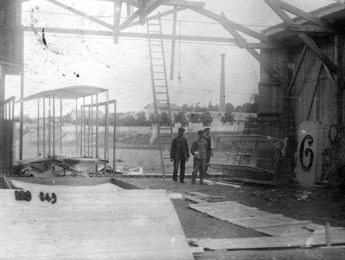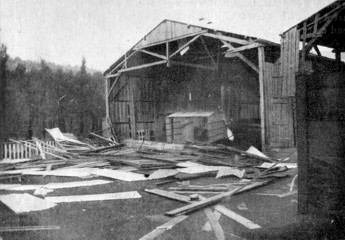Vichy, France, July 18th - 25th 1909
A troubled meeting, finished by a hurricane...








Vichy is a small spa town in the department of Allier in central
France, famous since Roman days for its hot springs and mineral water,
which was stated to be particularly effective against gout and kidney
stones. In 1909 Vichy had around 15,000 inhabitants, but every year
around 70,000 persons visited the town to bath, drink water and gamble
at the casino.
During the spring of 1909 a syndicate, including the Aéro-Club de Vichy
and the French Wright producers Ariel, started to build an airfield,
and the Aéro-Club de Vichy set up a prize fund of 10,000 francs for
flying competitions in their district. The airfield was situated near
Abrest, one kilometre from Vichy, on a peninsula that was formed by a
big bend in the river Allier.
The first meeting, the Grande Semaine d'Aviation, was originally
planned for 12-20 June. However, the installations were not ready until
the beginning of July, so the meeting was postponed until 18-25 July,
Sunday to Sunday. The constructions included grandstands and four
hangars, which were arranged so that their entrance was seen from the
grandstands.
The total prize money was 30,000 francs. The main event was the 16,000
francs "Prix de la Ville de Vichy", which was a
twenty-kilometre race over twelve laps of the 1.666 km (1.036 miles)
lap course. There were also prizes for the fastest lap, for the
"Prix de la Traversée de l'Allier", a four-kilometre race
outside the airfield crossing the river twice, for carrying the highest
number of passengers for five kilometres, and the "Prix
Hennessy" for the longest total time in the air during the
meeting. Efforts for the different prizes were scheduled for all the
different days of the week. Ariel, the French producer of Wright
aeroplanes was contracted and several more participants were expected.
However, in the end only seven competitors officially entered:
- Louis Blériot (Blériot)
- Léon Delagrange (Voisin)
- Hubert Latham (Antoinette)
- Louis Paulhan (Voisin)
- "F. de Rue" (Ferdinand Ferber) (Voisin)
- Paul Tissandier (Wright-Ariel)
- Armand Zipfel (Voisin)
The start of the week was slow. The first participants, Tissandier and Zipfel, didn't arrive until the opening day and only two or three pilots made any flights at all during the first days. Part of the problem was that the winds were rather high and no flights were allowed after six o'clock in the afternoon, when flying conditions were often at the best. Both Zipfel and "de Rue" had constant engine problems and hardly made any flights.
Sunday 18 July
After the opening of the meeting there was no sign of activity. After four hours of waiting the patience of the spectators wore thin. They rioted and invaded the airfield, calling the flyers thieves and cheaters. They were stopped before they reached the hangar area, but "L'Aérophile" reports that Tissandier had to deliver a "masterful punch" in the face of one of them. Zipfel was far from ready to fly, but Tissandier quickly assembled his plane and made a flight over the Allier towards the evening. This cooled the tempers, even to the point that he was carried in triumph to the hangars.
Monday 19 July
Tissandier tried to make a flight with a passenger, but the take-off failed and broke a landing skid.
Tuesday 20 July
After repairing the plane, Tissandier flew flew for more than ten minutes, but only three laps (5 km) in 6:17.5 officially counted. Zipfel made two unsuccessful test hops, finally breaking a wheel on the uneven ground and damaging the plane.
Wednesday 21 July
On the fourth day of the meeting there was at last some worthwhile flying. Tissandier made a magnificent flight of almost one hour. He completed 26 laps and posted times for the Prix du Passage de l'Allier (5:01.4), the Prix du Tour de Piste (1:52) and the Grand Prix de Vichy (23:29).
Thursday 22 July
Paulhan was finally ready on the Thursday. He had lost two days because he couldn't make a test flight from the uneven field and therefore couldn't adjust his tail incidence, which had gone out of trim during the transport. At around 19:00 he took off while Tissandier was already in the air, making what would be the winning flight for the "Grand Prix de Vichy". For three minutes, two or three laps, the two planes raced each other in the air, to the enormous enthusiasm of the crowds. Paulhan was ahead by 300-400 meters at the start, but Tissandier in his faster Wright gained visibly on Paulhan, who was forced to land soon afterwards. This was not the first time that two planes actually raced each other (the first was in Douai one week earlier), but since the Wright and the Voisin were more evenly matched they kept in contact for much longer.
Paulhan made another flight, completing nine laps. Towards the end of the day Tissandier took off for a flight with fellow aviation pioneer and future Wright pilot René Gasnier as passenger, but one of the rudders fouled the starting rail and the plane crashed again, this time breaking both landing skids and both propellers. This damage forced Tissandier to sit out the rest of the meeting.
Friday 23 July
With Tissandier and Zipfel out and "de Rue"'s engine problems it was up to Paulhan to save the meeting. On the Friday he had a narrow escape during an effort for the "Traversée de l'Allier" race. He had some mechanical problems and was forced to land on a small island in the river. The pilot and the plane were rescued by boat and Paulhan was back in the air soon afterwards.
Saturday 24 July
Paulhan took advantage of Tissandier's absence and won the "Traversée de l'Allier" race with a flight of exactly five minutes. "De Rue"'s engine problems continued, and he could only make a couple of short hops.
Sunday 25 July
Around lunchtime on the last day of the meeting, before the day's action had really started, disaster struck. A violent thunderstorm with heavy rains and hurricane-force winds caused havoc on the airfield. The main grandstand was blown over completely and a couple of the hangars collapsed. Tissandier's plane was reported as being completely wrecked when the roof and doors of the hangar fell over it and over the mechanics working on it, while Paulhan's had its left wing broken. "De Rue"'s hangar was completely lifted from the ground and moved one and a half metre. The left wing and the tail of the plane were crushed. Those who fled the hangars ended up in even bigger danger, since corrugated roofing panels were flying everywhere. The total damages were estimated to 50,000 francs.
The rest of the meeting was cancelled and the results were based on the flights that had taken place so far. This meant that Tissandier and Paulhan split the prize money, with Tissandier winning everything except the cross-country race over the Allier.
On the Sunday evening the Aero Club of Vichy organized a banquet for the competitors and officials, which hopefully compensated them somewhat for the effects of the weather.
Conclusion
Observers speculated that the short course with its tight turns suited the nimble Wright planes better than the more stable and less maneuverable Voisins. The airfield conditions definitely suited the Wrights better, since they started from rails.
The Vichy meeting was overshadowed by Blériot's channel crossing and was not very thoroughly reported in the press. The low number of participants was a disappointment for the organizers and the spectators, and the incidents on the opening day were not good for public relations. A total of two planes flying for a total of less than three hours during an entire week must have been a disappointment for everybody. The storm deprived the organizers from the possibility to extend the meeting by three days in order to compensate for the missed flying time, something that had already been decided in principle. The aviation press in general didn't regard it as a great success and particularly condemned the airfield conditions.
 Back to the top of the
page
Back to the top of the
page
